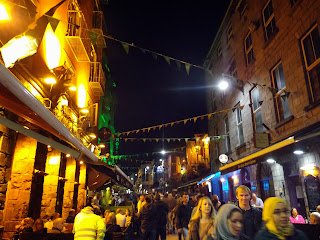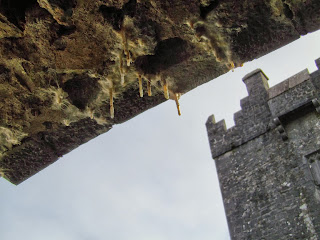28th September, 2013 –
Aran Islands. A highlight of our trip so far.
OK, so everything so far has been
a highlight. But today was really special!
Since it’s Saturday, Andrew &
Ramona came out to Galway to meet us for our day trip. Andrew had never been to
the Aran Islands before, although Ramona has been a few times. We booked a day
tour to Inishmor, which is the largest of the islands - there are 2 smaller
ones which you can visit as well but with only one opportunity this trip, we
went for the big one. Inishmore is around 18km long and 5km wide, and has a
population of around 800 – although this doubles on a busy day in the summer
holidays when up to 1000 tourists arrive!
We were pretty confident about
getting from our accommodation to the coach station, which we had seen signs to
from Eyre Square. Another beautifully sunny day as we walked through the
square.
Of course, when we got to the
coach station right on time, we couldn’t find the stand we were after. We asked
someone, who said “Ohhhh – you’ll be wanting the NEW coach station. That’s down
this street, across the road and to the right 500 metres”. So we were a little
late, but we got there! It’s a huge new coach station, all very clearly marked
INSIDE but not a lot outside to tell you where it is. Andrew and Ramona were
inside wondering where we were, so they were relieved that we got there in
time. The tour was a bus trip to Rossaveal, on the Galway coast, then a ferry
to the islands and a minibus tour of Inishmore with a local guide. The bus ride
passed through Galway suburbs into Connemara countryside, as the tour guide
played Irish music and told us some information about the Islands and some
corny jokes.
The ferry takes about 45 minutes
and we had a very smooth ride. We could soon see the town of Kilronan in front
of us.
We met our local guide and headed
off in the minibus. Our guide was very knowledgeable about the islands, and he
had a distinctive accent – the flow of words sounded more Welsh than Irish, and
some of his pronounciations were unusual – “threes” for “trees”, words starting
with D had a hard TH sound. He was very down-to-earth and didn’t like to make
any claims about anything he hadn’t seen for himself. “Those white rocks there
are not originally from the island – they’re not limestone, they’re graneeet.
They’ve come over from Galway, probably in the ice age. So the geologists will
be telling us, but I don’t know about that myself”. “See that garden? The man
there is into all this organic gardening. He grows vegetables. Those tall ones
are called artichokes. Art-ee-chokes. People eat them. So they say, but I don’t
know. Folks around here don’t eat them”.
The tour started in Kilronan and
the relatively lush, fertile areas nearby – the island is very exposed to wind
and has little topsoil over the limestone so this sheltered area is the only place
where tall trees can grow.
The whole island is criss-crossed
with thousands of stone walls – partly to divide up the fields, but also
because the stones have to go somewhere! The natural state of the island is
basically covered in stones.
Many of the houses are made of
stone, often white-washed and some with thatched roofs.
The thatching is expensive to
maintain, and many of the older houses are very small, so these are often
converted into sheds and barns.
There are also various “leprechaun
houses” around the island, which our guide was naturally very sceptical about.
Fuchsias grow wild on the more
fertile parts of the island and frequently need to be cut back. There are also
blackberries and currants, which you can pick and eat as you explore.
We stopped at Dun Aengus, an Iron
Age fort made of concentric rings of dry stone walls. It is thought to have
been mainly for ceremonial purposes rather than defence, as the chance of attack was fairly minimal
considering its position at the edge of a 300 foot high cliff!
It is a pleasant walk up to the
fort along a path surrounded by that distinctive Aran Islands landscape.
The views from the top are
amazing.
Our next stop was a spot called
the Seven Churches – “but I don’t know that there are really seven or if they
were all really churches. Some of them might have been houses” – a monastic
site from the 8th to 11th Centuries. There is a cemetery
with graves from those times right up to the last few years – the same family
names appear over and over, although the spellings vary a bit. By the way, the
island is a Gaeltacht area (Irish-speaking) – our guide considers it his first
language, although he was certainly fluent in English – and apparently it is a
slightly different dialect to the mainstream Irish language.
Our tour continued on through the
island, past a mix of cultivated and rock-covered areas. You can see that the
walls are completely dry stone with no mortar or anything to hold the stones
together.
Right at the tip of the island, we
stopped for a clamber over the rocks and a view towards the other 2 Aran
Islands. We could see some seals swimming in the sea but they didn’t come too
close.
There is a beach on the island
called Kilmurvey. It is a lovely beach with lots of white sand. A few people
were swimming, but it must have been cold!
After this we just had time to
head back to Kilronan for a drink and a bit of shopping before the evening
ferry back to the mainland.
Back to Galway city where we went
to McDonagh’s for fish and chips. Galway always seems to be busy in the
evenings, and tonight was no exception!



























































































